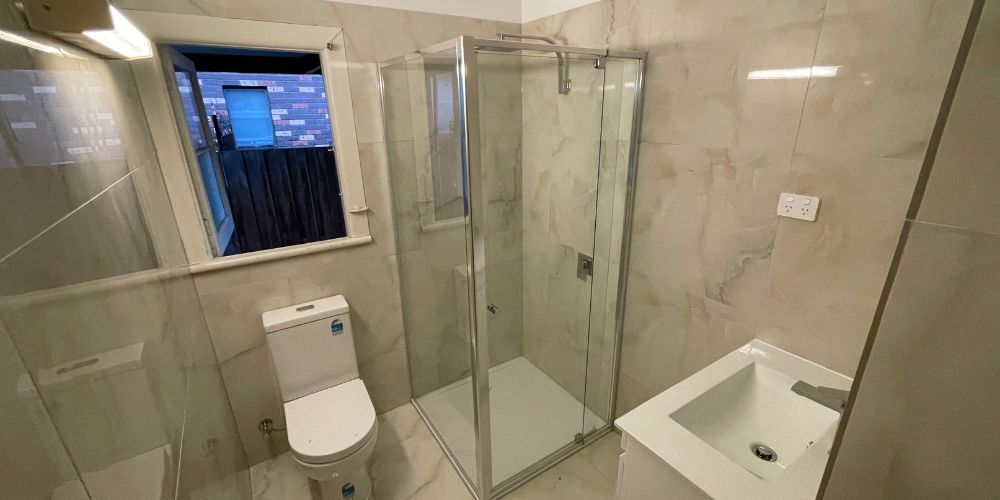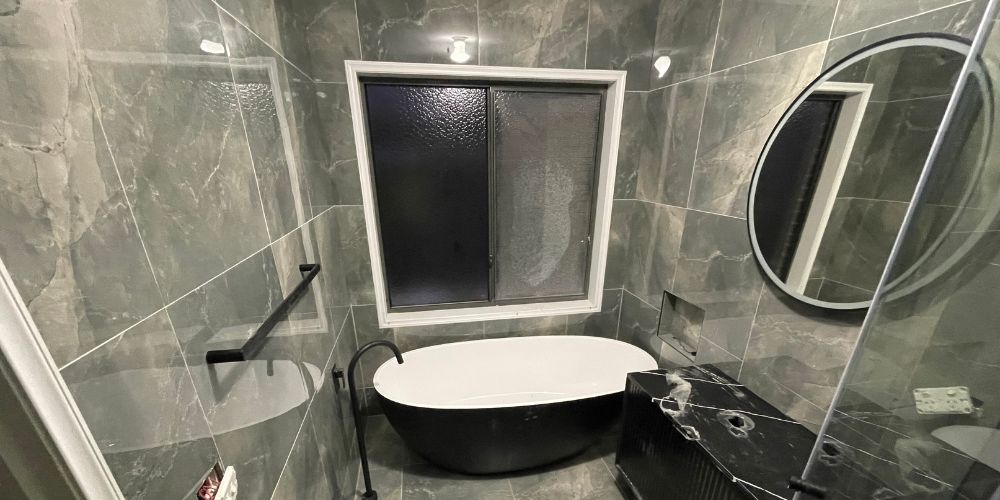Minimizing Disruption During Bathroom Renovation: A Guide for Homeowners
Table of Contents
Add a header to begin generating the table of contents
For homeowners, embarking on a bathroom makeover project may be exciting. Changing a drab place into a gorgeous, useful retreat is undeniably appealing. However, it is important to recognize that renovations might disturb our daily routines and cause difficulty if renovations are not managed properly. Homeowners may minimize such interruptions and keep things normal during the remodelling process with careful planning and proactive actions.
If you’re ready to begin your bathroom renovation adventure but want to avoid potential disruptions, this guide is for you. We’ll provide the knowledge and resources needed to limit interruptions, keep you on track, and make the most of your bathroom remodel.
So, let’s dig in and discover how to make your makeover easy and fun.

When Do You Actually Need a Bathroom Renovation?
Several situation-specific considerations will determine if you need to renovate your bathroom. First and foremost, your bathroom’s aesthetic is quite important. A remodel may make it into a contemporary, eye-catching place that matches your taste and improves the overall appearance of your house if it has antiquated fixtures and a worn-out design. Second, functional restrictions are a crucial factor. Using your bathroom might be inconvenient and ineffective if it has outdated plumbing, a bad layout, or insufficient storage. These problems may be resolved by remodeling, increasing the space’s utility and enhancing your everyday life.
To prevent future damage and provide a safe and healthy environment, it is essential to repair structural concerns in the bathroom, such as water damage, mould development, or decaying surfaces via restoration. To improve accessibility and safety, measures such as slip-resistant floors and grab bars should be included. Furthermore, upgrading to energy-efficient fixtures and appliances during remodelling may help create a more sustainable house while lowering power expenses.
How To Renovate Your Bathroom With Minimal Disruptions
Bathroom renovations may be disruptive, but with proper planning and preemptive steps, you can reduce the impact on your everyday life.
Here’s a step-by-step approach to renovating your bathroom with the least amount of disruption:
Step 1: Plan ahead of time:
- Make a detailed remodelling plan. List the improvements you wish to make, such as fixtures, finishes, and layout adjustments. This can help you express your ideas to contractors and give a clear path for the project.
- Create a realistic timeline. Collaborate with your contractor to create a timeline for each project step. Consider material supply, permit acquisition, and potential delays to guarantee a seamless process.
- Coordination with contractors and suppliers. Ensure everyone participating knows the project’s timeline and expectations. Regular communication will aid in resolving any possible disputes and keeping the project on schedule.
Step 2: Arrangements for Temporary Bathrooms:
- Create a temporary bathroom. If your property has many bathrooms, designate one as a temporary bathroom during the restoration. To ensure operation, equip it with necessary fixtures and facilities such as a toilet, washbasin and shower.
- Consider alternate bathing options. If a temporary restroom is not an option, consider other possibilities. To maintain personal hygiene during restoration, options include utilizing a neighbouring gym or hiring portable showers.
- Inform your family members or housemates about the temporary bathroom setup and any required alterations to their habits. This will assist everyone in adjusting to the changes and minimizing interruptions.
Step 3: Control of Dust and Debris:
- Prepare a containment zone. Use plastic sheeting or temporary barriers to separate the remodelling area from the rest of the house. This will keep dust and debris from migrating to other parts of the property.
- Install dust barriers. Install zippered plastic barriers between the remodelling area and the rest of the house to establish an airtight seal. This will assist in keeping dust at bay and reduce its influence on your living areas.
- Clean the workspace regularly. Plan frequent cleaning sessions to eliminate dust and debris from the remodelling area. During the project, this will contribute to a healthier and more habitable environment.
Step 4: Noise Control:
- Establish quiet hours. Talk with your contractor about setting aside times for minimizing loud work. This can assist you in maintaining a pleasant living environment, particularly in the early mornings or late evenings.
- If you need to work or rest near the remodelling area, try utilizing noise-cancelling headphones to filter out the noise.
- Plan other living arrangements. If the noise becomes too disturbing, you may want to consider temporarily staying with relatives or friends or renting a nearby accommodation to guarantee a more pleasant living environment while the restoration is underway.
Step 5. Clear Communication
- Keep lines of communication open with your contractor. Check in with your contractor regularly to resolve any issues or questions. This will assist in guaranteeing that the refurbishment goes well and that any difficulties are rectified as soon as possible.
- Discuss guidelines and expectations. Make it clear to the contractor what you want regarding noise levels, work hours, and cleanliness. This will aid in the establishment of boundaries and the reduction of disturbances.

Things To Consider During Bathroom Renovation
There are various crucial aspects to consider while renovating a bathroom to guarantee a successful and well-planned job. Here are some important considerations to make throughout your bathroom renovation:
- Budget: Create a budget and intelligently allocate cash to cover all restoration components, including supplies, labour, and unanticipated costs.
- Design and Layout: Carefully plan the design and layout of your bathroom, considering the available space and how you want it to work. Optimize the arrangement for both efficiency and appearance.
- Fixtures and Materials: Select high-quality fixtures, fittings, and materials that complement your style and budget. Consider durability, maintenance needs, and water efficiency.
- Storage: Provide enough storage to keep your bathroom organized and clutter-free. Include vanity cabinets, shelving, or built-in niches to store toiletries and other necessities.
- Professional Help: Seek expert advice from skilled specialists such as contractors, designers, and plumbers. Their knowledge will ensure a seamless refurbishment process, regulatory compliance, and high-quality craftsmanship.
Frequently Asked Questions
Maximizing storage space in a tiny bathroom is critical. Consider building a vanity with built-in storage, employing wall-mounted shelves or cabinets, using vertical space with tall storage units, and implementing storage solutions such as hooks or baskets. Customising storage to meet the available area can aid in functionality optimisation.
Depending on the degree of remodeling, you can use your bathroom. However, there may be times when the bathroom is temporarily unavailable owing to specialized chores such as plumbing or tiling. Setting up a temporary bathroom solution or working with your contractor to minimize disruption will assist.
The cost of remodeling varies greatly based on criteria such as bathroom size, degree of restoration, materials used, and location. It’s best to get multiple quotations from contractors and account for expenditures such as fixtures, labour, materials, and any unforeseen charges.
Local building rules and the restoration type determine the permit requirement. Minor, aesthetic alterations may not require a permit in certain situations, although large structural changes or plumbing work normally must. To establish the precise permit requirements for your project, speak with your local building authority or contractor.
Conclusion
A bathroom makeover may be an exciting project that improves your house’s utility, beauty, and value. Major issues such as money, design, fixtures, storage, and expert support must be considered to achieve a successful restoration journey.
Remember that staying organised, communicating efficiently with your contractors, and being prepared for any issues are important. You can successfully manage your bathroom makeover with dedication and the right resources, creating a place that genuinely represents your taste and satisfies your needs.
Don’t let your fear of interruption stop you. Accept the opportunity to change your bathroom into a relaxing and useful haven. Begin today and get the rewards of a beautifully refurbished bathroom that improves your house and everyday life.
Make your bathroom renovation a reality by leaping. Your perfect bathroom is waiting for you!
Like this article?
Share on Facebook
Share on Twitter
Share on Linkdin
Share on Pinterest

Chadi
Chadi, with 20 years of experience as a renovation builder specializing in bathroom and kitchen transformations. He brings structural expertise and a comprehensive skill set to every project, ensuring your renovation dreams become a reality.


